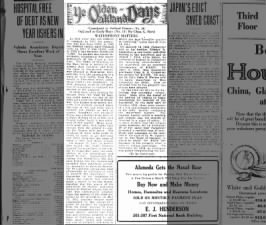.jpg)
Ye Olden Oakland Days
(Contributed by Oakland Pioneers - No. 28)
Oakland in Early Days (No. 11) By Chas. G. Reed
WATERFRONT MATTERS.
In 1850 there was one resident in Oakland; in 1855 the population was less than 1,000; in 1860 the Federal census gave Oakland 1553; in 1870 it was 10,500, and by 1875 it had between 30,000 and 35,000. Its growth was rather remarkable, considering the sparse population of the Coast at that time. The Town of Brooklyn on the East, being a portion of the present East Oakland, and from the Lake to Fourteenth avenue, was annexed in September, 1862, and this, with the annexation of a tract on the north, from Fourteenth to Twentieth street, added about 3,000 to the population. In 1874, Alameda voted on the question of annexation to Oakland, but decided in the negative.
In early days, upon entering the estuary from the West by boat, one could hardly see any of the town until near the foot of Broadway. The houses were mostly one story and scarcely showed above the tops of the oak trees which covered the blocks as well as streets, Broadway not excepted. Water was obtained from wells at a depth of from 20 to 25 feet; and though rather hard, it was otherwise of fair quality. Many windmills were built, with tanks high enough from the ground to supply the houses with water. The creaking of these mills could be heard at night in all directions and often disturbed the sleep of many a tired and weary citizen.
On August 27, 1853, as heretofore stated, the Town Trustees granted the waterfront in fee simple to Carpentier upon the completion of the schoolhouse and wharf by him. Immediately following this transaction, the citizens, feeling that the trustees had exceeded their legitimate authority, presented to them on September 10 a petition asking that legal proceedings be instituted at once to recover the waterfront. On September 19 the committee to whom the matter was referred made a report in writing recommending that the prayer of the petitioners be denied; and upon motion of Trustee Adams, this report was unanimously adopted. Upon the signing of the deed disposing of the waterfront, on May 31, 1852, matters became more complicated by the receipt of a power of attorney by Carpentier from his niece, Harriett N. Carpentier, empowering him "to purchase, deliver, receive and hold real and personal property in the State of California, and to sell, lease, grant, assign and convey any and all property now held or which she may 'hereafter acquire in California," under date of June 14, 1852.
On January 18, 1853, Carpentier sold to his brother, Edward R. Carpentier, a one-fourth undivided interest in the waterfront and on August 2, 1854, while Mayor, he conveyed to Harriet N. Carpentier the remaining three-fourths of the waterfront for an expressed consideration of $60,000. On April 4, 1855, Miss Carpentier purchased from E. R. Carpentier his interest for $12,000. On August 16, 1855, John B. Watson sold the entire waterfront to Miss Carpentier for $6000. How he obtained title to this property has always been debated.
By this time the title to the waterfront was somewhat complicated. Soon after the denial of the petition of citizens to begin proceedings for recovery of the waterfront, in the early part of October, 1853, there were rumors of a riot and probable destruction of the town records containing the waterfront matters. The trustees hastily called a meeting and ordered that the records be removed to a place of safety. It is quite evident that the citizens meant business, for on November 19 of the same year Carpentier presented a certified copy of complaint and summons to the trustees in the case of H. W. Carpentier vs. The Town of Oakland, in which he asked for $4500 for damages to his property from a mob or riotous assemblage. On November 11, 1854, an ordinance was passed compromising the suit.
(To be Continued)
Sun, Feb 6, 1921 – Page 42 · Oakland Tribune (Oakland, California) · Newspapers.com




